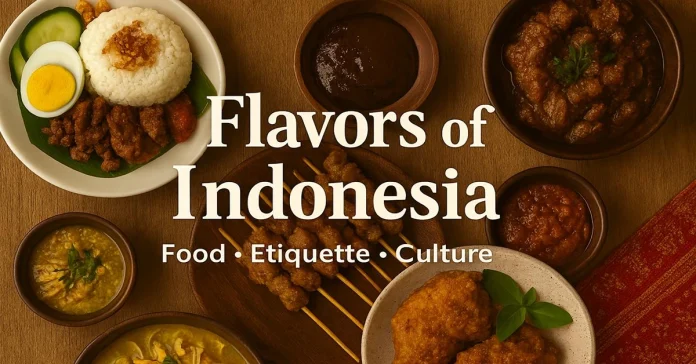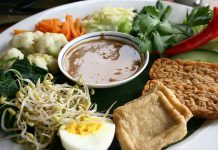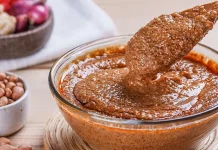A Culinary Mosaic: The Spirit of Indonesian Food
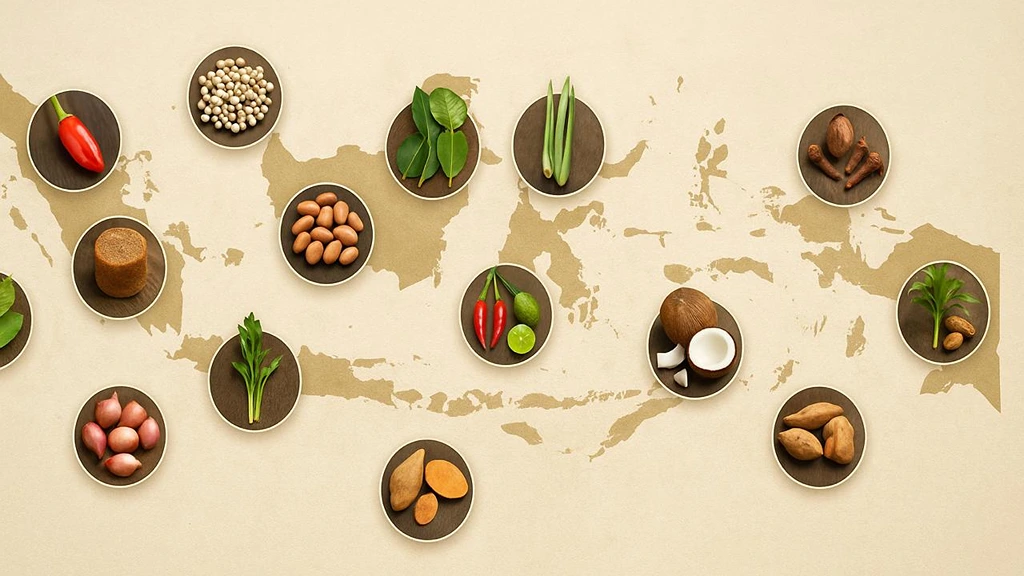
Indonesia is more than a tropical paradise — it’s a culinary wonderland made up of over 17,000 islands and 1,300 ethnic groups. Each island adds its own colour to the country’s food scene, creating a vast palette of flavours, traditions, and stories.
From the bold spiciness of Sumatra to the sweetness of Java and the aromatic freshness of Bali, Indonesian cuisine is a celebration of balance and diversity, mirroring the national motto:
“Bhinneka Tunggal Ika” — Unity in Diversity.
Rice: The Heartbeat of Every Indonesian Meal
In Indonesia, rice (nasi) is more than just a staple — it’s the soul of the nation. Every grain carries meaning, representing life, gratitude, and community. Across the islands, rice is served not merely as food but as a blessing.
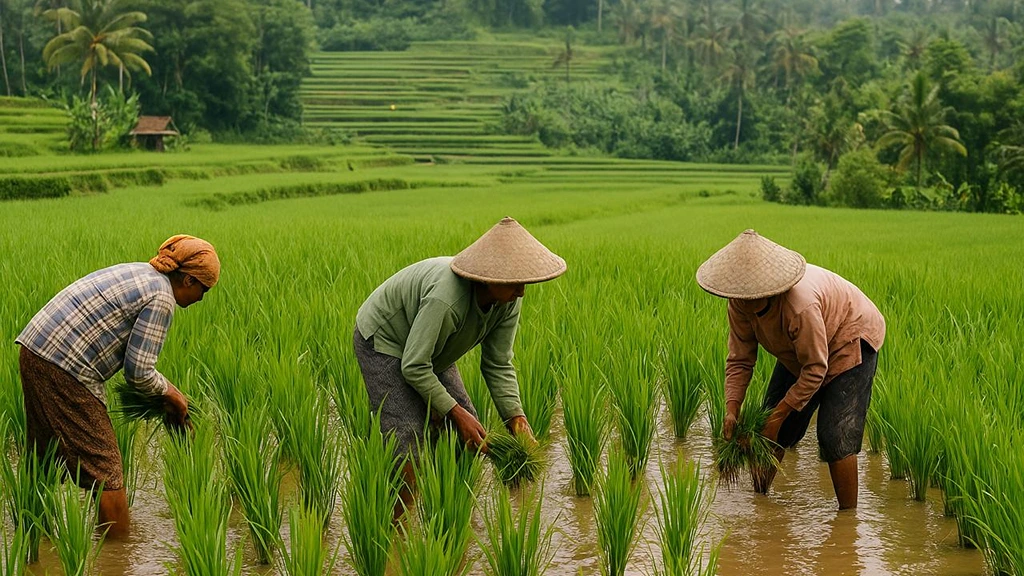
A Sacred Symbol
Rice holds a deeply spiritual role in Indonesian life. It features in religious ceremonies, ancestral offerings, and even folk tales passed down for generations. Many farmers still pay homage to Dewi Sri, the revered goddess of fertility and rice, before planting or harvesting — a gesture of respect to ensure abundance and balance.
A Daily Necessity, Not a Choice
For Indonesians, a meal isn’t truly a meal without rice. A popular saying captures this perfectly:
“Belum makan kalau belum makan nasi” — You haven’t eaten until you’ve had rice.
It’s not just a saying — it’s a way of life. Breakfast, lunch, or dinner, rice is always at the centre of the table, anchoring every dish around it.
Even Global Brands Adapt
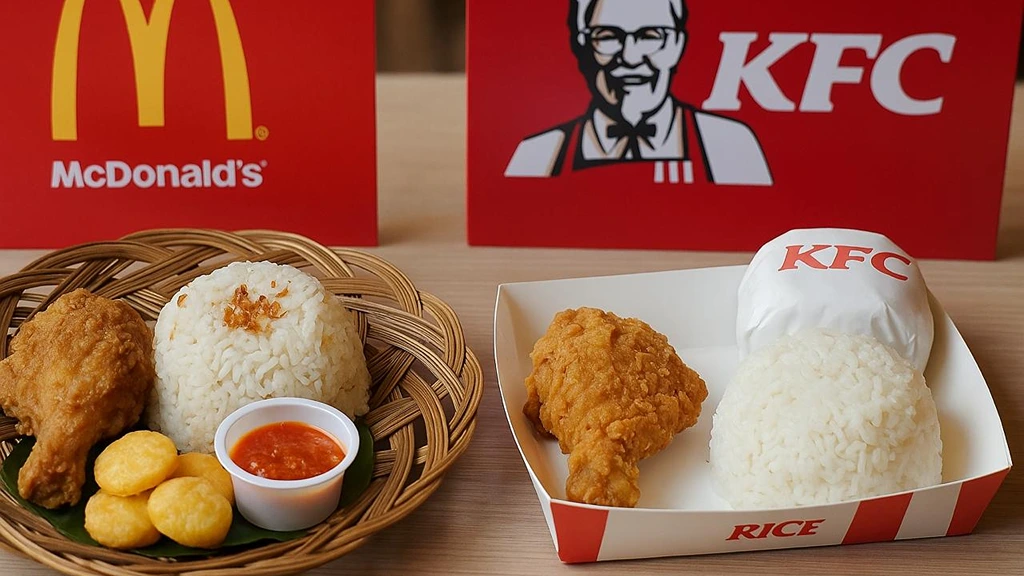
Rice’s importance runs so deep that even international fast-food giants have adapted to Indonesia’s palate. Chains like McDonald’s and KFC both serve fried chicken with white rice and sambal as standard — not as an exotic add-on, but as a default meal combo. Both Brands also serve Nasi Uduk — a fragrant coconut rice usually reserved for local warungs. Pizza Hut offers Oriental Chicken Rice and Black Pepper Rice dishes alongside its pizzas, while Taco Bell created an Indonesia-exclusive Bell Rice topped with sambal korek and grilled chicken.
Fun Fact: McDonald’s Indonesia once ran the slogan “Ayam Goreng McD – Nikmatnya Juara” (“McD Fried Chicken – A Champion Taste”) — proving that, in Indonesia, rice and fried chicken beat burgers any day.
The Big Five: Regional Cuisines of Indonesia
Sumatra – Spices and Bold Flavours
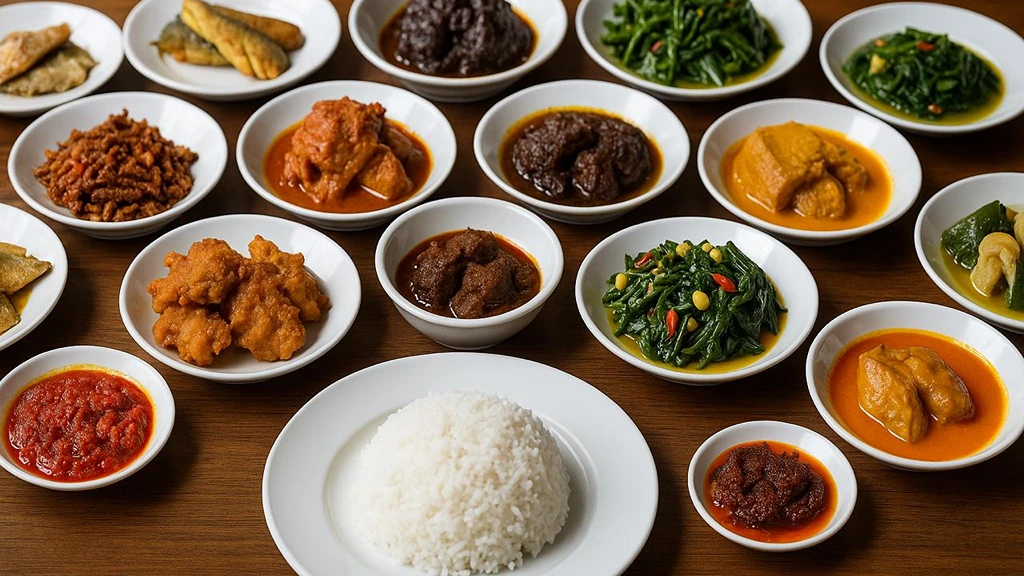
Sumatra’s food hits you with spice, smoke, and soul. This is the home of Padang cuisine, where Rendang — slow-cooked beef in coconut milk and spices — was once crowned the world’s tastiest dish. Dishes like Gulai (rich curry) and Sambal Ijo (green chilli sambal) make every meal an adventure. Tip: Don’t be alarmed when 20 dishes land on your table at once — it’s Padang style! You only pay for what you eat… unless you “accidentally” finish everything.
Java – Sweet, Savoury, and Soulful
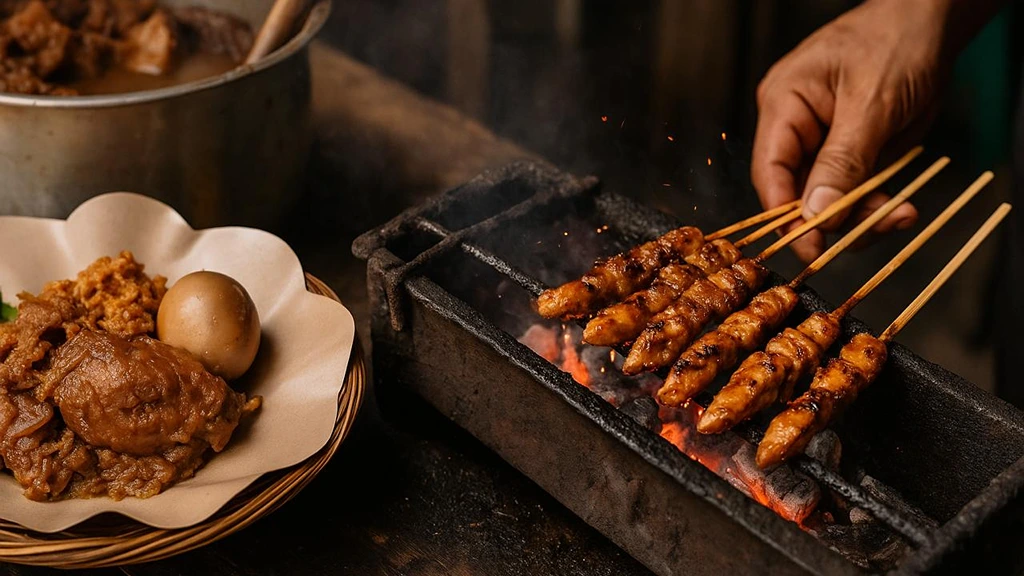
Javanese food is like its people — gentle, balanced, and full of heart. The famous Gudeg from Yogyakarta, made from young jackfruit stewed in coconut milk, offers comfort in every bite. Street favourites like Gado-Gado (warm salad in peanut sauce) and Ketoprak (tofu, vermicelli, and sprouts in peanut sauce) bring health and indulgence together. And of course, no Javanese feast is complete without Sate Ayam, smoky grilled chicken skewers dipped in peanut sauce.
Tip: If the peanut sauce spills everywhere, congratulations — you’re eating it the authentic way
Bali – Harmony on a Plate
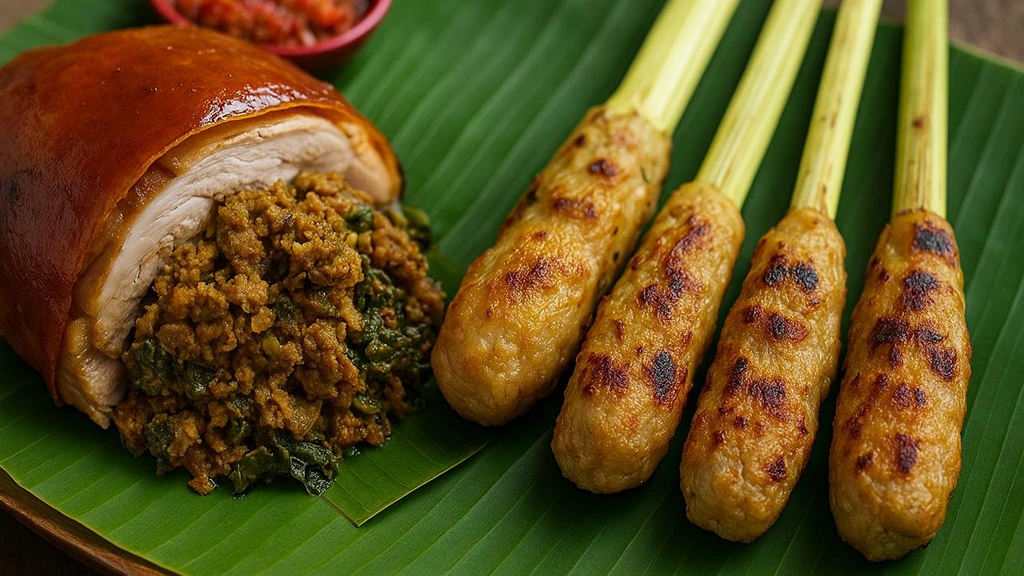
Bali’s cuisine reflects its spiritual heartbeat — flavorful, colourful, and deeply connected to ritual. Dishes like Babi Guling (spit-roasted pig) and Lawar (spiced meat and vegetable mix) are central to ceremonies, while Sate Lilit (minced fish satay wrapped on lemongrass) adds a fragrant twist.
Tip: Don’t rush your meal here — every bite deserves the same calm as a Balinese sunrise.
Sulawesi – Bold, Coastal, and Adventurous
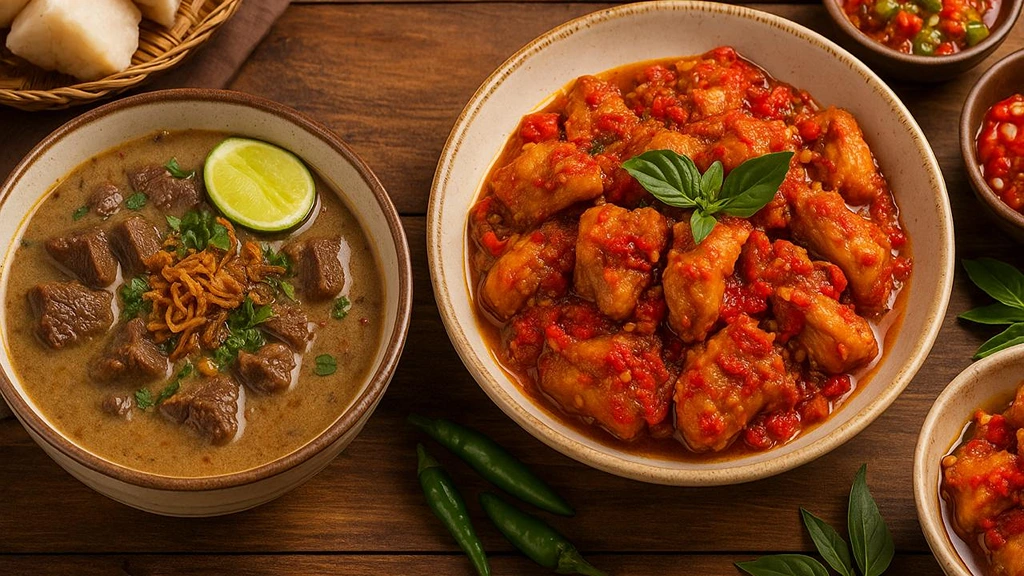
Sulawesi cuisine isn’t for the faint-hearted — it’s rich, spicy, and full of surprises. Coto Makassar (a peanut-based beef soup) and Rica-Rica (chilli-loaded dishes) show off the locals’ love for heat.
Tip: If your lips are burning, don’t reach for water — grab rice or sweet tea instead. Water just makes the chilli angrier.
Kalimantan – Rustic, Earthy, and Wild
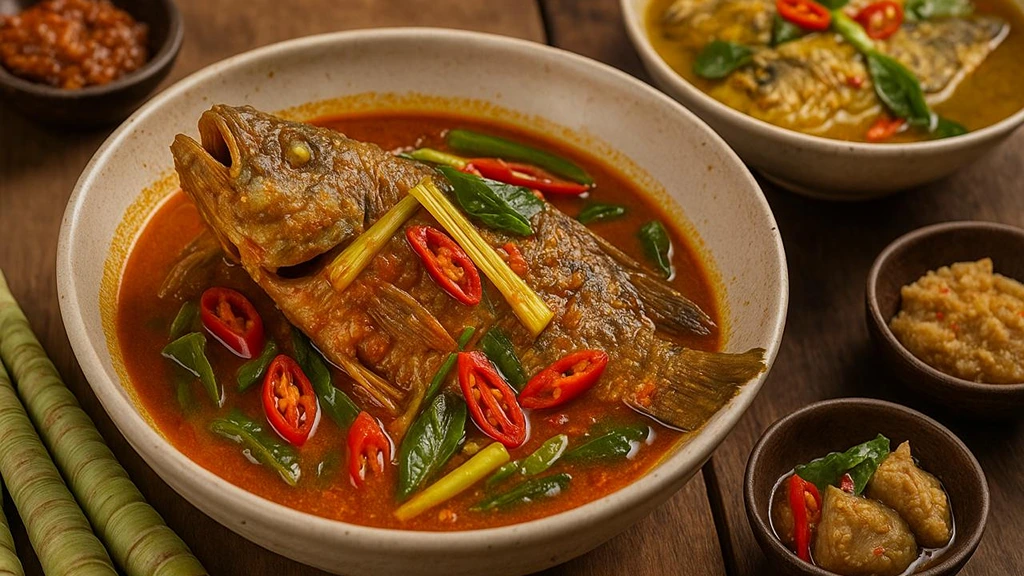
The food of Borneo (Kalimantan) celebrates forest and river life. Dishes like Ikan Baung Asam Pedas (sour-spicy river fish) and Sayur Rotan (rattan shoots cooked in coconut milk) are both rare and refreshing. (Rattan here refers to the tender inner shoot of the palm, not the furniture!)
Tip: Try everything once — Kalimantan’s flavors are unlike anything you’ll find on the mainland. You might discover your new favorite ingredient grows where you least expect it.
Savory Bites – Indonesia’s Everyday Favorites
Indonesia’s street food scene is where the real magic happens — smoky woks, clanging ladles, and the kind of aromas that make you forget your destination. It’s food made with instinct, served with heart, and best enjoyed on a busy roadside, surrounded by laughter and chatter.
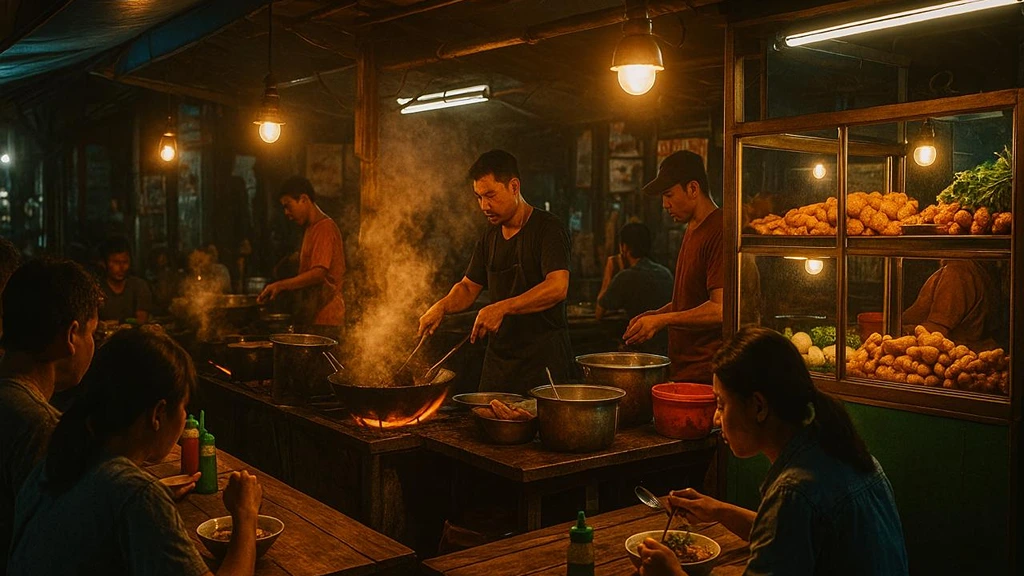
Nasi Goreng – Indonesia’s iconic fried rice, cooked with sweet soy sauce (kecap manis), egg, meat and vegetables.
(Best eaten anytime — especially after a long night out when you swear it’s your last plate… until tomorrow.)
Mie Goreng – Stir-fried noodles tossed with veggies, chicken, and a generous spoon of sambal. Simple, satisfying, and impossible to get wrong.
(If your lips aren’t tingling by the end, you probably need to find a spicier stall.)
Indomie Rebus – Instant noodles taken to national treasure status. Comfort in a bowl, often topped with an egg and a splash of chilli oil.
(There’s no “correct” way to make it — just your way and everyone else’s wrong way.)
Bakso – Beef meatballs floating in savoury broth, served with noodles, tofu, and fried shallots. A comfort food loved by schoolkids and late-night wanderers alike.
(Don’t say you’ll stop at one bowl — no one ever does.)
Gorengan – Anything fried becomes gorengan — tofu, tempeh(fermented soybean cake), cassava, bananas, even vegetables. Crispy, cheap, and irresistibly addictive.
(You’ll tell yourself it’s just a snack. It never is.)
Nasi Campur – Literally “mixed rice,” a perfect reflection of Indonesia itself — diverse and full of surprises. A plate piled with rice, sambal, tempeh, eggs, vegetables, and maybe some meat or tofu.
(Every bite’s a lucky draw — and somehow, every mix works.)
Nasi Uduk – Fragrant coconut rice served with fried chicken, sambal, and crunchy toppings. A breakfast favourite that feels like home.
(The trick is to eat it slowly — but you won’t, because the aroma alone doesn’t let you.)
Nasi Padang – A masterpiece from West Sumatra — rice served with an array of fiery curries, sambals, and the legendary rendang.
(There’s probably a secret addictive spice in those gravies — because once you’ve tried Nasi Padang, every other meal feels like a warm-up act.)
Sweet Treats & Traditional Desserts — Happiness by the Spoonful
Indonesia’s desserts are not just sweet — they’re stories wrapped in coconut, palm sugar, and nostalgia. You’ll find them on street corners, night markets, and in every grandmother’s kitchen, served with a smile that says, “Eat more.”
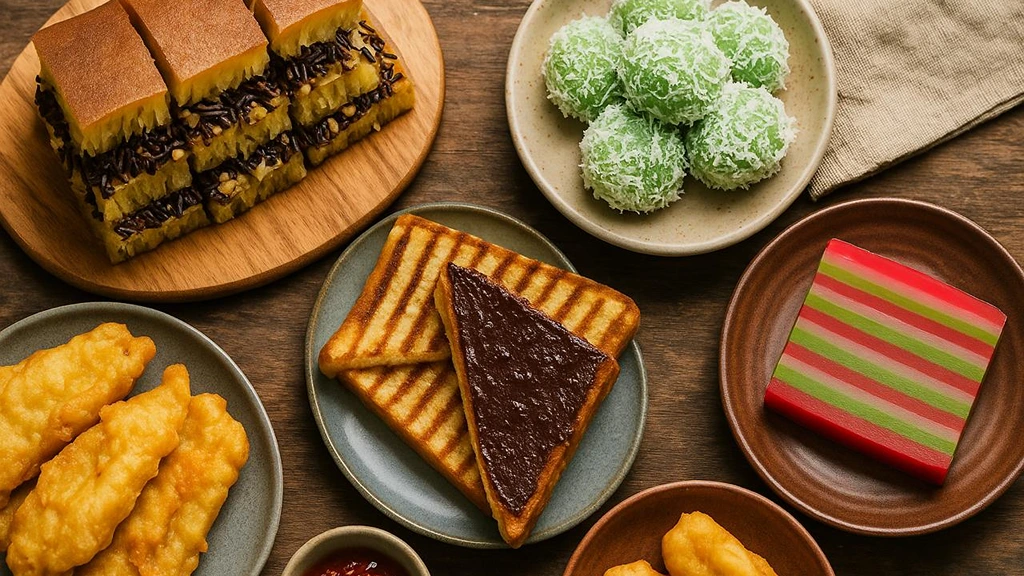
Martabak – A thick, buttery stuffed pancake loaded with chocolate, cheese, peanuts, and condensed milk.
(Health-conscious? Look away when it’s being made — the butter might make your diet cry. Just eat and thank the culinary gods later.)
Klepon – Glutinous rice balls filled with molten palm sugar and coated in coconut flakes.
(Pop it whole in your mouth — bite halfway and you’ll wear the filling instead of tasting it.)
Kue Lapis – Rainbow-colored layered cake made from rice flour, coconut milk, and sugar.
(Patience is key — it’s so pretty you’ll hesitate to eat it. But don’t wait too long, someone else will.)
Roti Bakar – Grilled toast slathered with chocolate, cheese, or jam — Indonesia’s answer to midnight cravings.
(Best enjoyed past 10 p.m. when all diet rules magically stop applying.)
Pisang Goreng – Crispy fried banana, golden on the outside and soft inside.
Pisang Bakar – Grilled banana drizzled with chocolate, condensed milk, or cheese — a smoky twist on the classic.
(If it’s raining, it’s officially Pisang Goreng/Bakar weather. Pair it with tea and instant happiness.)
Es Cendol – Iced dessert made with green rice-flour jelly, coconut milk, and palm sugar syrup.
(The perfect antidote to Indonesia’s heat — sweet, cold, and impossible to sip gracefully.)
Es Shanghai – A colorful mix of fruits, shaved ice, and syrup — Indonesia’s take on a tropical snowstorm.
(The rule: the messier it looks, the better it tastes.)
Es Kopiyor – A refreshing drink of tender coconut mixed with syrup, milk, and crushed ice.
(Like the beach, but without the sand between your toes.)
Traditional Drinks — Sip the Soul of Indonesia
From smoky mountain teas to coconut-laced coolers, Indonesia’s traditional drinks are made to refresh your body and revive your spirit. Some soothe, some jolt you awake, and all come with a story — and probably too much sugar.
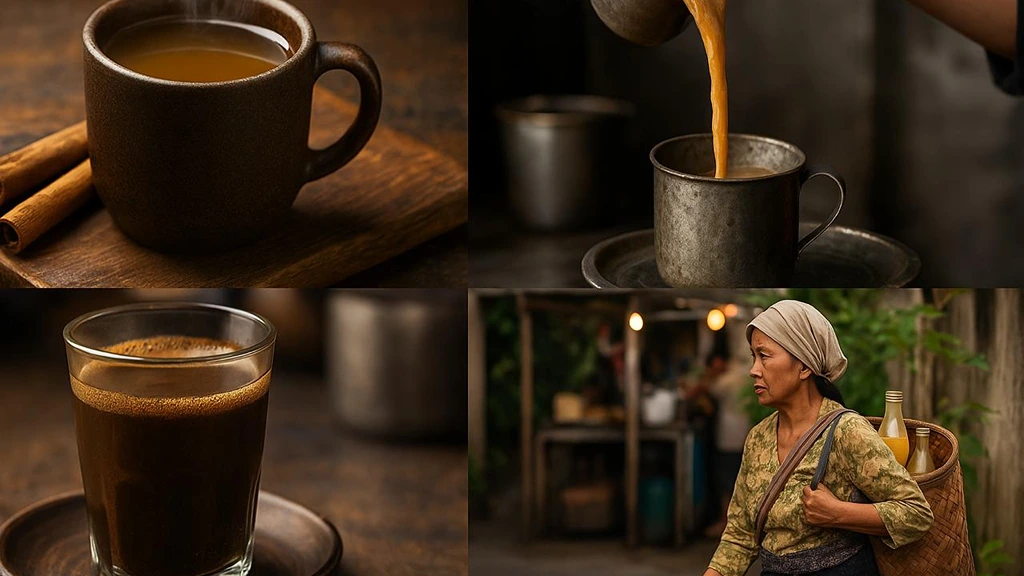
Teh Tarik – Pulled milk tea frothed to perfection by “pulling” it between two cups.
(If the tea isn’t being thrown dramatically through the air, it’s just ordinary tea.)
Wedang Jahe – Hot ginger tea brewed with palm sugar and spices.
(Cures colds, sore throats, and possibly heartbreak — though results may vary.)
Bajigur – A warm, sweet drink made from coconut milk, palm sugar, and a hint of ginger.
(Best enjoyed on a rainy night with fried snacks — the cozier, the better.)
Bandrek – Another fiery ginger drink with cloves, cinnamon, and a bold attitude.
(Guaranteed to warm you faster than your ex’s texts ever did.)
Kopi Tubruk – Bold, unfiltered Indonesian coffee where the grounds settle at the bottom — thick, grainy, and unapologetically strong.
(Don’t stir it too much or you’ll end up drinking half the coffee plantation.)
Kopi Luwak – The world’s most famous (and expensive) coffee, made from beans “processed” by civet cats.
(Try not to think too hard about how it’s made — just sip and smile.)
Popular Indonesian Restaurant Chains that Celebrate Tradition
Indonesia’s culinary spirit thrives not only in street-side warungs but also in restaurant chains that have mastered the art of keeping traditional recipes alive while reaching millions across the archipelago. Each chain tells a story — of regional pride, heritage, and the shared joy of eating together.
Sederhana – The undisputed king of Nasi Padang. Found in almost every Indonesian city, Sederhana brings the bold flavours of West Sumatra — rendang, ayam pop, and sambal hijau — to your table. The name may mean “simple,” but the taste is anything but.
Pagi Sore – A rival in flavour to Sederhana, Pagi Sore is famed for its rendang so rich and addictive that many locals swear it’s the best in the country. Their signature spice blend is a well-guarded secret — one bite and you’ll understand why.
Bebek Kaleyo – Jakarta’s go-to for crispy duck perfection. Their bebek goreng sambal korek (fried duck with raw chilli sambal) is dangerously good — the kind of dish that makes you sweat, smile, and reach for more rice.
Sate Khas Senayan – A national favourite known for its elegant take on sate ayam, soto ayam, and gado-gado. With roots in Javanese and Balinese cuisine, this chain proves that traditional food can be served with both authenticity and flair.
Es Teler 77 – What started as a humble dessert stall has become a household name. Famous for es teler — a sweet, icy mix of avocado, jackfruit, and coconut — as well as hearty classics like bakso and mie ayam. Dessert and comfort food, all in one stop.
Bakmi GM – A Jakarta icon since the 1950s, this noodle house serves the country’s favourite bakmi ayam and pangsit goreng. It’s proof that a simple bowl of noodles can carry decades of nostalgia and national pride.
Warung Upnormal – A new-generation chain that celebrates local comfort food with a modern twist. Think Indomie rebus with creative toppings, roti bakar, and kopi susu — served in a cosy café atmosphere that still feels distinctly Indonesian.
From the fiery kitchens of Padang to the smoky grills of Java, these restaurants remind us that tradition doesn’t have to fade — it just finds new ways to stay deliciously alive.
Reflection — A Nation on a Plate
Indonesian food is more than the sum of its spices. It’s the smoky streets of Jakarta, the coconut-scented kitchens of Bali, the communal feasts of Sumatra, and the cosy tea stalls tucked between mountains. Each dish — from fiery sambal to creamy desserts — tells a story of resilience, creativity, and joy.
In a country with thousands of islands, it’s comforting to know there’s one thing that unites everyone: the love of good food — eaten with hands, shared with laughter, and served from the heart.


